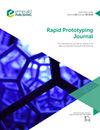硅树脂3D打印装置的硬度和模量可编程调整及实验
IF 3.6
4区 工程技术
Q1 ENGINEERING, MECHANICAL
引用次数: 0
摘要
目的本研究的目的是制造具有不同硬度和模量的有机硅产品,从而部分解决变形取决于结构或尺寸变化的均质材料的局限性,并为有机硅软结构的设计提供新的尺寸。设计/方法/方法设计并构建了一个具有双通道打印能力的软材料三维打印平台。使用材料挤出法,首先使用单通道印刷进行材料筛选,然后对具有不同硬度和模量值的产品进行双通道调节印刷实验。添加剂的比例对印刷品的准确性有影响。材料筛选显示Sylgard 527和SE 1700可以在没有添加剂的情况下印刷。产品的硬度和机械性能与硬材料和软材料在其组成中的百分比有关。产品的硬度可以从26A调节到42A,杨氏模量可以从0.875调节到2.378 Mpa.Originality/value现有的通过铸造或印刷成型的有机硅产品大多由单一材料组成,其均匀的硬度和模量无法满足结构中差异变形的要求。现有的多硬度有机硅材料印刷方法存在材料混合时间长、硬度切换慢、多挤出头切换复杂等问题。在本研究中,提出了一种简单、低成本、响应灵敏的硅材料挤出硬度可编程制备方法。本文章由计算机程序翻译,如有差异,请以英文原文为准。
Hardness and modulus programmable tuning for silicone 3D printing device and experiment
Purpose
The purpose of this study was to fabricate silicone products that had different hardnesses and moduli, thus partially addressing the limitations of homogeneous materials whose deformation depends on altered structure or dimensions, and to provide new dimensions for the design of silicone soft structures.
Design/methodology/approach
A soft material three-dimensional printing platform with a dual-channel printing capability was designed and built. Using the material extrusion method, material screening was first performed using single-channel printing, followed by dual-channel-regulated printing experiments on products having different hardness and modulus values.
Findings
The proportion of additives has an effect on the accuracy of the printed product. Material screening revealed that Sylgard 527 and SE 1700 could be printed without additives. The hardness and mechanical properties of products are related to the percentage in their composition of hard and soft materials. The hardness of the products could be adjusted from 26A to 42A and the Young’s modulus from 0.875 to 2.378 Mpa.
Originality/value
Existing silicone products molded by casting or printing are mostly composed of a single material, whose uniform hardness and modulus cannot meet the demand for differentiated deformation in the structure. The existing multihardness silicone material printing method has the problems of long material mixing time and slow hardness switching and complicated multi-extrusion head switching. In this study, a simple, low-cost and responsive material extrusion-based hardness programmable preparation method for silicone materials is proposed.
求助全文
通过发布文献求助,成功后即可免费获取论文全文。
去求助
来源期刊

Rapid Prototyping Journal
工程技术-材料科学:综合
CiteScore
8.30
自引率
10.30%
发文量
137
审稿时长
4.6 months
期刊介绍:
Rapid Prototyping Journal concentrates on development in a manufacturing environment but covers applications in other areas, such as medicine and construction. All papers published in this field are scattered over a wide range of international publications, none of which actually specializes in this particular discipline, this journal is a vital resource for anyone involved in additive manufacturing. It draws together important refereed papers on all aspects of AM from distinguished sources all over the world, to give a truly international perspective on this dynamic and exciting area.
-Benchmarking – certification and qualification in AM-
Mass customisation in AM-
Design for AM-
Materials aspects-
Reviews of processes/applications-
CAD and other software aspects-
Enhancement of existing processes-
Integration with design process-
Management implications-
New AM processes-
Novel applications of AM parts-
AM for tooling-
Medical applications-
Reverse engineering in relation to AM-
Additive & Subtractive hybrid manufacturing-
Industrialisation
 求助内容:
求助内容: 应助结果提醒方式:
应助结果提醒方式:


